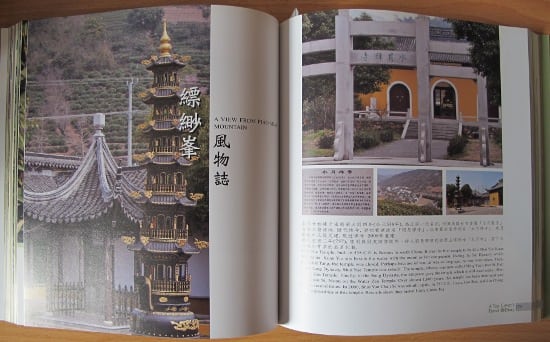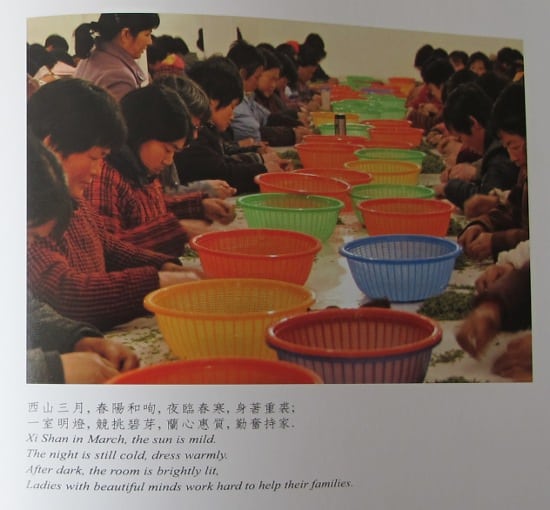Which one of the following teas does not belong in the following list and why?
- Dragonwell
- Bi Luo Chun
- Mao Feng
- Gunpowder
Take your time to think about it…
The correct answer is … Gunpowder. No not because it blows things up, the Dragonwell dragon can do much worse than that. No, it is because the teas are the teas described in the book “4 World-Famous Chinese Teas: A Tea Lover’s Travel Diary II” by Jason C.S. Chen. Hmmm, 4 teas, we have three teas left in the list above. What is the fourth? Well, it is Gunpowder, sort of, or actually more subtile it is and is not Gunpowder. Are you still here?
The book
The book is the second book in a currently of 2 books existing series about tea. In these books a couple of teas are described. Each tea has its own section. Each section starts with 2-4 pages of history, production and quality notes. After that there are a lot of pictures showing and describing the environment in which the tea grows, step by step, photo by photo the production process of the tea and at last the preparation of the tea. Each tea-section ends with a few pages with the personal experiences of the author with the teas and their production.
So in essence it is a photobook showing the teas, their production and their environment. A littlebit of text gives a littlebit of background information. And that text is the weak part of the book. There is so much more to tell about the teas in terms of mythology, history and market that the few pages given are far too short. Even only one or two extra pages of text for each tea could have made the picture much more complete.
Nevertheles the stories told by the photo’s are gold and to be honest these are what the book is all about. They take you into China and onto the production floor. You can almost smell the teas, oh wait I actually can, but I will come back to that later.
The book has an introduction by James Norwood Pratt and a foreword by Pierce B. Watters. It is written in two languages: Chinese and English. A few times it was fun to see that the Chinese and English text differ at some places, without being able to read Chinese that is.
The author
Jason C.S. Chen travels a lot through the tea world with his camera and notebooks to study and photograph tea. In 1997 he started “CC Fine Tea corporation” an American tea seller with his own gardens. So the choice of gardens for the book reflects is not completely independent.
The teas
The teas in this book are all green (surprise?), but each has its own distinctive production method. The fermentation could be stopped with air-firing or pan-firing. Withering could be done in or outdoors. Or there could be an extra dry phase. So the teas were chosen to reflect different ways of tea production. Of course there are a lot more ways to produce green teas, but then there would not be enough for another diary focussing on green teas. By the way, book I focusses on 2 oolongs.
Now what was that with Gunpowder?
Ah yes the tea that was or was not Gunpowder. The fourth tea is called “Ping Shui Ri Zhu” or “Green Pearl”. The story of this tea is that it began during the Song Dynasty. At the end of the Qing dynasty the quality of the tea declined and the tea evolved from “Green Pearl” into Gunpowder. The tea described in the book is actually an attempt to create a new incarnation of Green Pearl, using modern production techniques. Of course the producers and the author call this something new and special. Norwood calls it Gunpowder. Considering that the first batch was produced in 2011, I think that it is too early to tell whether this is a “new” tea or just a new kind of Gunpowder. I have not tasted it yet. But then again who am I.
Reading the book
Each tea has its own section, so each tea got its own reading session. Therefore each tea got its own pot full of tea. And what better tea to make than the tea of the section. So make sure you have enough tea to make 1 or 2 pots of each. And of course some extra leaves to feel, smell and taste while you compare them to the photo’s. For me this means I have to start rereading the book again once they are in my personal stock again. For now I could follow my own advice only for 2+ sections.
So remember to get:
- Dragonwell
- Bi Luo Chun
- Mao Feng
- Ping Shui Ri Zhu a.k.a. Green Pearl (or Gunpowder if nothing better is available)
before starting to read the book.
Exercise for who is going to read the book: There is a major hint that the layout of the sections was copied and then adapted to another tea. Can you find it?
Overall impression
A good and easy book to read and leaf through. It does not tell a complete story of each tea, but it tells a lot about them and increases the insight in different methods of green tea production and their results. To be enjoyed with the right kind of tea. Now which teas do I have to order for part one…
- Chen, Jason, “4 World-Famous Chinese Green Teas: A Tea Lover’s Diary II”, 2012. (amazon.com) (worldcat)



What an interesting looking book Bram. Where did you find it? Or how did you hear about it? Thanks for giving us a good introduction. I hadn’t heard of it before, wonder if anyone else here has? Did you take the top picture with the tea? It’s really beautiful! What about the first book in the series, do you have that too?
Not sure where I first encountered it. It has been on my wish list before it was available. Probably the finding of book one led me to book two. My Amazon wish list tells me that I added that one on August 30 last year, with 3 other tea books added on the same day. So I might have found that one just by searching for tea books on Amazon. Something I do from time to time.
No, I don’t have book one yet, but I will some day. I chose to start with book two because I’m more familiar with the teas.
The photo’s are mine. That is the photo’s of the book, not those in it ;).
Never even HEARD of this book. Then again, my tea literature tastes is infantile at best. Thanks for the look.
Hi Bram,
Solution to the exercise:
page 13: for both the Bi Luo Chun and the Mao Feng sections start with an introduction called “About Bi Luo Chun”.
page 226: the section is called “About Bi Luo Chun” instead of “About Mao Feng”.
Apart from this error there are also others: Montain altitudes are given in km. On page 73 for example there is a not so high mountain with a height of 168 km (!) I guess that this should be 168 m or on page 184 a small mountain that rises to 336 km (!),
Otherwise this is a nice book, as is the first book which seems to have less errors. 😉
I forgot that one. 🙂